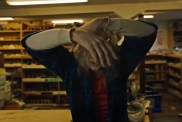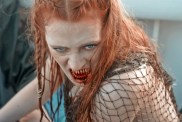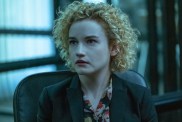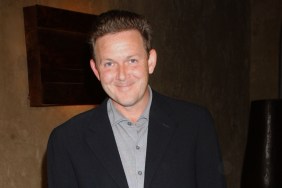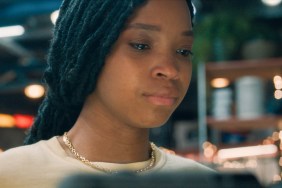
SHOCK sits down with veteran genre moviemaker Rolfe Kanefsky for a 2part chat.
One of the unsung filmmakers and screenwriters working diligently in the independent circuit, Rolfe Kanefsky has created a niche in the horror and cult genres with vividly entertaining films such as the ahead-of-its-time cult favorite THERES NOTHING OUT THERE (1991), the horror films CORPSES (2004), THE HAZING (2004), JACQUELINE HYDE (2005) and NIGHTMARE MAN (2006, which was part of the 8 Films to Die For series), and other cult favorites such as PRETTY COOL (2006), and the film noir thriller ONE IN THE GUN (2010). Kanefsky has officially worked in every genre, including animation and family films, but it’s horror that remains his specialty. He’s just finished directing a new horror film called The Black Room, starring Natasha Henstridge, and he remains a stalwart filmmaker with a persuasive style and humor that is all his own.
After years of hard work and film after film and project after project that consistently entertain, Kanefsky’s films as a whole reflect a vision and perspective that deserve recognition.
Here is the first part of a two-part chat with Kanefsky. Enjoy…

SHOCK: Why did you become a filmmaker?
KANEFSKY: Well, I fell in love with storytelling at a very early age. I was born in New York City and I grew up in Westchester. We moved there when I was about three and a half. My father, one Sunday, turned on the T.V. and I caught the very end of Abbot and Costello Meet Dr. Jekyll and Mr. Hyde. It was a little scary, but it was slapstick, and I thought it was great. From that point on I tuned in every Sunday at 11:30 and watched all of the Abbot and Costello movies. Pretty quickly I started coming up with my own Abbot and Costello stories, although I couldnt write yet. I had babysitters and I would translate and they would write the stories. Eventually I started writing. I was just born with an interest to tell those kinds of stories. I have a love of comedy and obviously comedy / horror. I just really enjoy making people laugh or making them jump. Its just a great feeling.
SHOCK: Your father, Victor Kanefsky, has been involved in the making of many of your films as well as the making of other films. How has your father helped you over the years in terms of filmmaking?
KANEFSKY: My father was an independent editor and eventually ran his own company called Valkhn Films. He had basically become a documentary editor and was involved in many big documentaries. He got involved in National Geographic at an early stage. Some of them were award-winning documentaries. He had an infamous relationship with Joel M. Reed, the director of Bloodsucking Freaks (1978), and Blood Bath (1976), and he edited Bloodsucking Freaks for him. I remember I was five or six years old when they were editing that film. He wouldnt let me come in the editing room where they were cutting. Now I can see why. When I was in high school I rented it out because I was renting every horror film I could find. Id heard about it and I was shocked when I saw my fathers name on the screen. Hes in the movie too at the beginning. In college it became like an endurance test to see if people could watch it all the way through. Some people find it hysterically funny. Word is that Woody Allen owns two copies. Other people cant stand it, and I can understand why. Its one of Eli Roths favorite films. On the DVD Eli Roth is interviewing my father for the commentary.
SHOCK: Did you ever interact with or meet Joel M. Reed?
KANEFSKY: Im sure I met him when I was very young, but I met him later at a screening. We all hung out and he told the most outrageous stories. He had seen my first film Theres Nothing Out There (1991), but I never got to know him really.
SHOCK: What is it about horror films that appealed to you so much?
KANEFSKY: I had terrible nightmares growing up. I didnt watch horror films, but in 1979 I saw Invasion of the Body Snatchers in the theater, and we only saw it because it was PG, which I still cant believe. I had nightmares for weeks after that film. I loved comedy; I would get scared at horror films. I really didnt get into horror until I was 14 years old because at that point I had made a decision to be a director and since most first time filmmakers start out with a horror film, I thought Id better learn the genre. So I started watching every horror film on videotape to really learn the craft. This was 1983, 1984. The films that stood out were Halloween (1978), Phantasm (1979), Evil Dead (1982), the Elm Street films, the roller coaster films. There are the ones that really try to get under your skin and disturb you and there are the roller coaster movies which are like amusement park rides or funhouses – you scream, you laugh. You leave exhilarated.
SHOCK: At what point did your love for watching movies turn into a desire to make movies of your own?
KANEFSKY: Well, I guess it was around the age of 13 or 14. I got a video camera and I started making home movies with the neighborhood kids. They were chase films, little comedy routines. When I was about 15 I did my first official short, which had a beginning, middle, and an ending. It was called Breaking and Entering; it was a little horror comedy. I did it with a friend and we edited in the camera. Even though my father was an editor, we did it ourselves. I went from that to a 52 minute short called Undead, and that was sort of inspired by Sleuth (1972). That was my first official horror film, I guess you could say, because it had a nightmare sequence, some gore effects, and we blew up a house by using Amityville 2 (1982) stock footage. Around that time I went to HB studios to learn screenwriting. I took the course and went to sci-fi and horror conventions and learned about filmmaking. At 16 I did my first feature-length film on video and it was a Goonies-type adventure which took two years to make. It was supposed to be just a summer of fun, but it turned into a whole different thing. After that, I started doing PA work because my father got me into some sets. That was a good experience. I suffered through that, and I got a few more jobs. One movie I worked on just came out on DVD, Posed For Murder (1988), and I have a small part in that at the end. I worked on Tromas War (1988), the biggest film Troma did. On these movies, I was a runner; I did all kinds of stuff. I did everything on Tromas War. I was grip and gaffer, I carried lights. I worked with the craft service; I always make friends with the craft service people. Half the people who worked on that movie quit. I finally left too.

SHOCK: You had made Theres Nothing Out There already while you were doing production assistant work. What was that like, taking orders from people after having made a film yourself?
KANEFSKY: I did it basically to make some money. We had edited the film and were waiting There was nothing else going on. My father got me a few of the jobs. It was a good experience. I was able to appreciate how much the crews really work. Ive never believed in the auteur theory, even though Ive written and directed most of my films and even produced some of them, theres just so many people involved in the making of a film. When directors are credited with A Film By or A Movie By, it seems a little conceited which is why when I did my first movie, Theres Nothing Out There, I finally went with Flick to downplay the whole egotism thing. Ive went with that ever since. I was told that if you didnt put a possessive title on the film, it meant that there was something wrong with it, and I thought, Well, thats not true.
SHOCK: There was a long gap between Theres Nothing Out There and your next movie, My Family Treasure (1993). What was the reason for that?
KANEFSKY: It wasnt that long of a gap. We shot Theres Nothing Out There in 1989. We finished it in 1991. It was such a low budget, we had to defer the effects for awhile. We showed it at Fangorias Weekend of Horrors in May of 1990, and the response was very positive. It was hard to sell it, though. We got into several film festivals. By some coincidence, I was able to show it to Robert Zemeckis over at Amblin. He watched the whole film with just his assistant and myself and my cousin who had done some PA work on Ricochet (1991). My cousin had met Zemeckiss wife, and theyd gotten to talking about my movie, and she said, Well, thats just how Robert and Steven (Spielberg) got started! He should see the film! They made a few calls to verify that my movie was real, and two weeks later, the screening happened. That was the only back door to get into something like that.
SHOCK: Did you get a sense of what he thought of the film?
KANEFSKY: I think he liked it. He didnt love it. At the time, he was one of the producers of Tales From the Crypt for HBO, which would have been a great lead-in for my movie. Unfortunately, that was the season when all of the big stars like Tom Hanks and Schwarzenegger were directing episodes. He wasnt blown away by it his advice was that, Well, obviously, you know how to make a movie. Write a really good script that people want and say you want to direct it. Show them this movie and theyll see you know how to direct. Which I did. I traveled with the movie, I think it opened in 1992 on one screen wherever it went. Laemmles heard about the film, so we went from New York to Santa Monica. We got really good reviews from the L.A. Times. We built up an audience at midnight shows and then the L.A. riots happened, and all midnight movies in Los Angeles were stopped due to a curfew. Luckily, because we played in New York City, these producers for a film called My Family Treasure, which was an unfinished film that had been shot in Russia for eight weeks, were looking for a more American slant on their movie, which had been directed by a Russian director. They hadnt finished it because everything in Russia had changed, and what they had was dated, so it was unfinished and old. They liked Theres Nothing Out There, even though their film was more family-oriented, but they brought me on board to do the new scenes. I shot for a week in New York, which amounted to a half-hour of the movie to restructure the film. That was my first experience working with 35mm, and I worked with Dee Wallace Stone and Alex Vincent, the child actor who was in the Childs Play movies. What I did was look at the film that they had, which was a two-and-a-half hour cut of the Russian footage. They wanted to do an original set-up in America, and so I suggested the whole thing be a flash-back. I wrote all the new material, and came up with ways to dissolve the Russian scenes with the New York scenes.

SHOCK: The Russian stuff was boring.
KANEFSKY: Yeah, there was a lot of silly humor in that. They asked me if I wanted a writers credit on the film, but I took a story by at the end credits because I didnt want people to feel that Id written the Russian stuff. I brought my dad on as the editor and Ed Hershberger, whod shot Theres Nothing Out There, shot the New York scenes for me.
SHOCK: Theres a nice Childs Play (1988) reference in the movie.
KANEFSKY: I threw in the Chucky doll, it was Alexs own doll he had. I threw in a reference of Night of the Living Dead (1968) too.
SHOCK: The opening title sequence by Michael Ventresco is impressive. Do you have anything to say about that sequence?
KANEFSKY: Well, it was actually in the screenplay that I wrote. I write very visually oriented. The concept was that the girl gets attacked inside a car, a tentacle comes up, covers the camera, and we sort of go inside the tentacle. People say its sort of a Dr. Who kind of tunnel of green. The camera never stops moving during the title sequence, so when it emerges inside the classroom, I thought it gave it a very slick look.
SHOCK: Christopher Thomas did the score for this film, and its a great addition to the movie. What can you tell me about him and his contribution?
KANEFSKY: This was one of his first things and he was very good. We were looking for musicians, and we got demos and he sent us some pieces of music that were really fun. I told him that I wanted the music to pretty much be straight, because if youre doing a comedy you should normally never do comedy music in a comedy unless youre doing a cartoon kind of comedy. The score had to be straight – I wanted it to sound like an action / horror movie. I think he got into Hans Zimmers company afterwards. That was the last Id heard of him.
SHOCK: Youve mentioned that you shot the entire film on videotape before shooting on film. Thats unusual.
KANEFSKY: I called it video storyboarding. We videotaped the movie and rehearsed it. There was a steady cam shot in the film thats like a two-and-a-half minute shot that goes through the whole house with every character we shot that in rehearsals on video about 35 times to get it right. So when we shot it on film we only had to do four takes. Thats the kind of thing that if you hadnt planned it, thered be no way you could shoot that because it would cost too much money. Video storyboarding is a great tool.
SHOCK: Have you done that with your successive films?
KANEFSKY: Almost with every film. Usually it takes about a week of rehearsal time. It also makes the actors a lot more comfortable.
SHOCK: You once said that you made Theres Nothing Out There because you thought that making a horror film was the best and easiest way to break into the movie business, but horror was not in when you made that movie. If you had known that horror was not in at the time, what type of movie would you have made instead?
KANEFSKY: Its hard to say. My instincts are always with comedy, and obviously Theres Nothing Out There is as much a comedy as it is a horror film. The problem is that comedies really rely on the names. People ask: One, is it funny? and Two, whos in the movie? if youre doing a low budget, independent feature, you cant afford the big comedians, so thats a very hard genre to break into. If youre doing an action or sci-fi film, you have to have a certain amount of special effects or car chases and explosions, and thats very pricey. This was long before Tarrantino, so the influence of Pulp Fiction (1994) for crime thrillers wasnt there yet. I dont know. Horror never goes away. When we decided to do Theres Nothing Out There, Id written five screenplays so far. Out of all of them, Theres Nothing Out There was the most usable because it was all in one location, and we thought it was something we could do on a budget. If I hadnt done that, I probably would have just waited longer.

SHOCK: The scene where the operating sound boom is used as an escape route is classic. Do you still get comments about that?
KANEFSKY: The only movies that have crossed the line like that were Mel Brooks films. The boom story goes that in the original screenplay the character was supposed to swing out on a chandelier and leave. But the house we were in didnt have a chandelier. By coincidence, I went to a movie while we were filming and they projected it too low and you could see the boom and the audience was hysterical because you were so aware of it. So I figured that people were so aware of the process of moviemaking nowadays that it would be fun to actually play on that expectation where they think, Well, this is a low-budget horror film, it looks like they made a mistake. And then instead of it being a mistake, the character sees the boom like the audience does and he jumps and swings out on it with Raiders of the Lost Ark (1981) parody music playing. The whole crew was against it. They were like, You cant do this, youre crossing the line. The whole movie was constantly causing people to scratch their heads – these two guys are having a Pink Panther fight in the middle of a horror film – what is this? The nice thing about having your father being your producer on your first film is I was given the freedom that a studio would almost never ever give you. They would say, No, no, no, you cant do it. The boom scene became one of the most talked about scenes in the film. Almost all the critics, and even the people who didnt like the movie, said, But it does have one classic moment – the boom swing. It was such an unusual gag that people did embrace it and talk about it. The one very important thing that that taught me as a filmmaker was if theres something people call you crazy for and tell you wont work, usually thats the big, memorable moment of your film. Whenever Ive done a movie afterward and people tell me, You cant do that! I know I have to do that. Same thing happened with the tongue scene in The Hazing (2004), and thats now the scene that everyone talks about. Theres a dance scene in Tomorrow By Midnight (1999) thats a great moment.
Join us next week for more on Kanefsky’s fascinating career in genre cinema…
